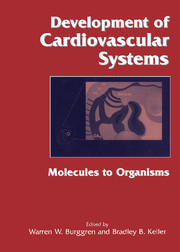Book contents
- Frontmatter
- Contents
- List of contributors
- Foreword by Constance Weinstein
- Introduction: Why study cardiovascular development?
- Part I Molecular, cellular, and integrative mechanisms determining cardiovascular development
- 1 Genetic dissection of heart development
- 2 Cardiac membrane structure and function
- 3 Development of the myocardial contractile system
- 4 Vasculogenesis and angiogenesis in the developing heart
- 5 Extracellular matrix maturation and heart formation
- 6 Endothelial cell development and its role in pathogenesis
- 7 Embryonic cardiovascular function, coupling, and maturation: A species view
- 8 Hormonal systems regulating the developing cardiovascular system
- Part II Species diversity in cardiovascular development
- Part III Environment and disease in cardiovascular development
- Epilogue: Future directions in developmental cardiovascular sciences
- References
- Systematic index
- Subject index
1 - Genetic dissection of heart development
from Part I - Molecular, cellular, and integrative mechanisms determining cardiovascular development
Published online by Cambridge University Press: 10 May 2010
- Frontmatter
- Contents
- List of contributors
- Foreword by Constance Weinstein
- Introduction: Why study cardiovascular development?
- Part I Molecular, cellular, and integrative mechanisms determining cardiovascular development
- 1 Genetic dissection of heart development
- 2 Cardiac membrane structure and function
- 3 Development of the myocardial contractile system
- 4 Vasculogenesis and angiogenesis in the developing heart
- 5 Extracellular matrix maturation and heart formation
- 6 Endothelial cell development and its role in pathogenesis
- 7 Embryonic cardiovascular function, coupling, and maturation: A species view
- 8 Hormonal systems regulating the developing cardiovascular system
- Part II Species diversity in cardiovascular development
- Part III Environment and disease in cardiovascular development
- Epilogue: Future directions in developmental cardiovascular sciences
- References
- Systematic index
- Subject index
Summary
Introduction
Along with the evolution of the closed chordate circulation, which contains blood at relatively high pressures, came the evolution of a highly muscular heart with valves separating low- and high-pressure chambers and of a vasculature lined throughout by endothelium (see Chapter 9). How is this seamless tubular system fashioned?
The myocyte has been the focus of much of the molecular work to date concerned with heart development. Yet the heart is constituted of cells with many fates, varying in specialized function from conduction to secretion to contraction. Furthermore, it has not been feasible to address at a molecular level essential issues of cardiovascular morphogenesis, especially with reference to larger-scale organotypic decisions (Fishman & Stainier, 1994). For example, are there genes that determine heart size? Are there genes that demarcate chamber borders? Are there single genes crucial to the fashioning of organotypic structures, such as endocardium or valves? Are different vascular beds assembled differently? Although many approaches might be envisioned, genetics has already proven to be powerful in revealing binary decisions during development in Drosophila and Caenorhabditis elegans. We explore here the possibilities offered by three genetic systems-Drosophila, mouse, and zebra fish-to discover the earliest molecular decisions that fashion the cardiovascular system.
Drosophila: The power of genetic screens in invertebrates
Drosophila heart development
The fly heart is a simple tubelike organ that is located at the dorsal midline beneath the epidermis and that extends nearly the length of the body. The circulation is open.
- Type
- Chapter
- Information
- Development of Cardiovascular SystemsMolecules to Organisms, pp. 7 - 17Publisher: Cambridge University PressPrint publication year: 1998



